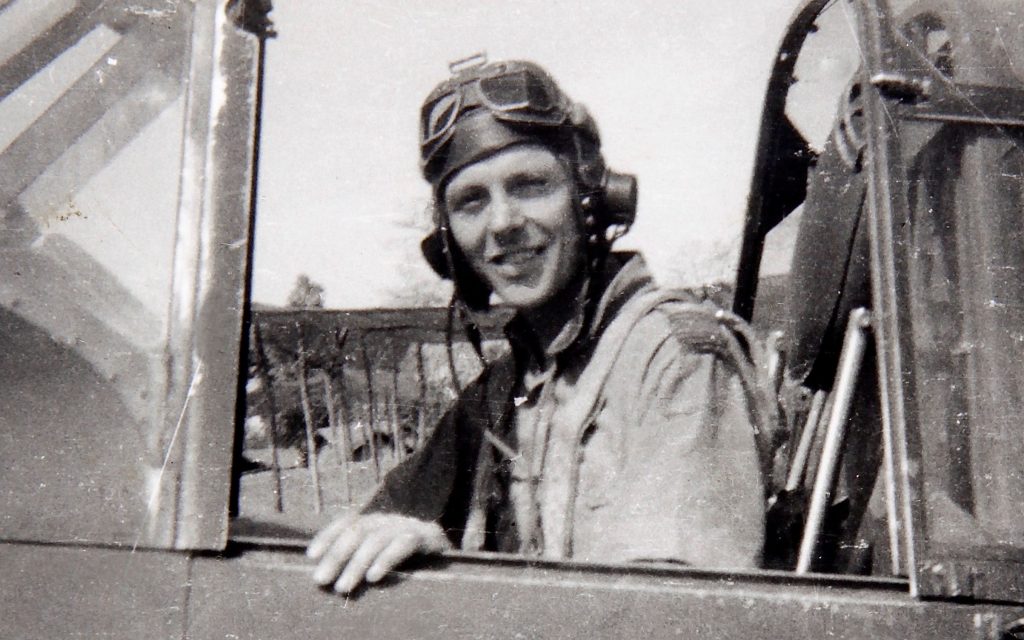British RAF personnel are not generally well known for their prowess as Dive Bomber pilots during WW2, being more well known as fighter pilots or heavy bomber crew on famous aircraft such as the Halifax or Lancaster.
However, Arthur Gill broke that mould and became probably Britain’s best ever Dive Bomber pilot although his name has been lost in time, most likely due to his theatre of operations which was in the Middle and Far East.
Despite this, his story is remarkable and warrants telling, as against all the odds he survived the war and went on to reach the grand old age of 100, which is one reason why we have decided to include him here. Amongst other trials, the whole his squadron was annihilated in Sumatra and Java in March 1942, he being the sole surviving officer, so here is a brief chronology of his wartime experiences.
Arthur Murland Gill was born in Finchley, north London on February 24 1916 and was educated at the Royal Commercial Traveller’s School, Pinner. He joined the RAF Volunteer Reserve in 1937, trained as a pilot and was called up on the outbreak of war, where he completed his training before heading for South Africa as an instructor.
In September 1941, he joined 84 squadron at Habbaniya near Baghdad, Libya flying the Bristol Blenheim bomber but within a month the squadron moved to the western desert in Egypt. Gill completed more than 20 operations before the squadron was rushed to the Far East following the Japanese attacks against Malaya and Singapore in the early part of 1942.
By the time Gill and his section reached the area, Singapore was about to fall, so he headed for Palembang in Sumatra. Landing after a night bombing sortie Gill’s aircraft hit a large crater on the runway and was wrecked. The situation in Sumatra soon became chaotic and the RAF forces were ordered to evacuate and relocate to Java, Indonesia.
Having lost his aircraft, Gill coordinated the destruction of weapons and surplus equipment before organizing the withdrawal of the ground party. He was the last man to board the last ferry to Java. On February 17 it was decided to evacuate all non-essential personnel and surplus aircrew, and they sailed for India in March 1942.
Of the 605 officers and airmen who had left Egypt just 132 reached India safe and well and Arthur was the senior surviving officer of 84 Squadron to arrive in India, where the unit was rebuilt and re-equipped with the American-built Vultee Vengence dive bomber.
After many months of re-organisation and training, Gill was able to demonstrate his squadron’s capabilities to Admiral Lord Mountbatten and Major General Orde Wingate. They were impressed and Wingate sought the squadron’s support for his forthcoming Chindits expedition. The squadron flew its first operation in the country on February 16, 1944 when Gill led 14 of his aircraft to attack Japanese positions in the Arakan State. Attacking in a near vertical dive, the Vengeance crews placed their four 500 pound bombs with great accuracy, sometimes just 100 yards ahead of Allied troops. In fact, Gill’s Squadron was so effective that it was in constant demand by army commanders.
He led attacks in support of the British 14th Army and Orde Wingate’s special forces group, before becoming heavily involved in the battles around Kohima and Imphal. Despite having to contend with the monsoon weather, Gill lead attacks in a desperate attempt to relieve the men at Kohima, bombing within yards of the beleaguered troops and later received a signal from the Garrison that typically said, “You’re bombing a bulls eye, bloody good show”.
Over the coming months, Gill was in constant action often leading formations of 24 aircraft when the much-maligned Vengeance aircraft became a key element of the RAF attack force. Besides supporting ground forces, Gill led attacks against bridges over the Irrawaddy river, rail yards and enemy stores areas.
On July 16 the squadron flew its last Vengeance combat mission when Gill spearheaded 12 aircraft targeting an ammunition dump at Le-U. It was his 108th Sortie in Burma almost all as the leader of large formations.
He regularly received signals of congratulations from Army commanders in the field and following this one, the Air Officer Commanding signalled Gill commenting, “Thank you for your work in 221 Group. In five months, you (The Group) have carried out 1,800 sorties, dropping over 900 tons of bombs. Good luck.” The leader of the Chindits General “Joe” Lentaigne, thanked him for his, “First class co-operation and support.”
Gill was awarded the DFC but was disappointed the rewards to his squadron particularly the ground crew, were so paltry. After the war he remained in the RAF and flew with the Overseas Ferry Unit and commanded several maintenance units where he tested aircraft before they were returned to the squadrons. He served on the Air Staff in Egypt and Cyprus and was awarded the OBE for his work at HQ Signals Command. He eventually retired from the RAF in March 1971 after over 34 years of continuous service.
As we have already mentioned above, Wing Commander Arthur Gill was one of the few survivors from his squadron after the Japanese overran the Dutch East Indies but with great courage and tenacity he re-built his Squadron (84 Sqn) and went on to become the RAF’s leading dive-bomber pilot during the campaign in Burma.
Gill was always greatly admired by his men, staff and superiors and in fact on the occasion of his 100th birthday in 2016, members of the current 84 Squadron flew from Cyprus to join him in his celebrations…..he died a few hours after they left the party, almost as though he knew he must play out that final act.
He had married Doris Hammond in 1948, six years after their first meeting in India and she, their son and two daughters all survived him.
